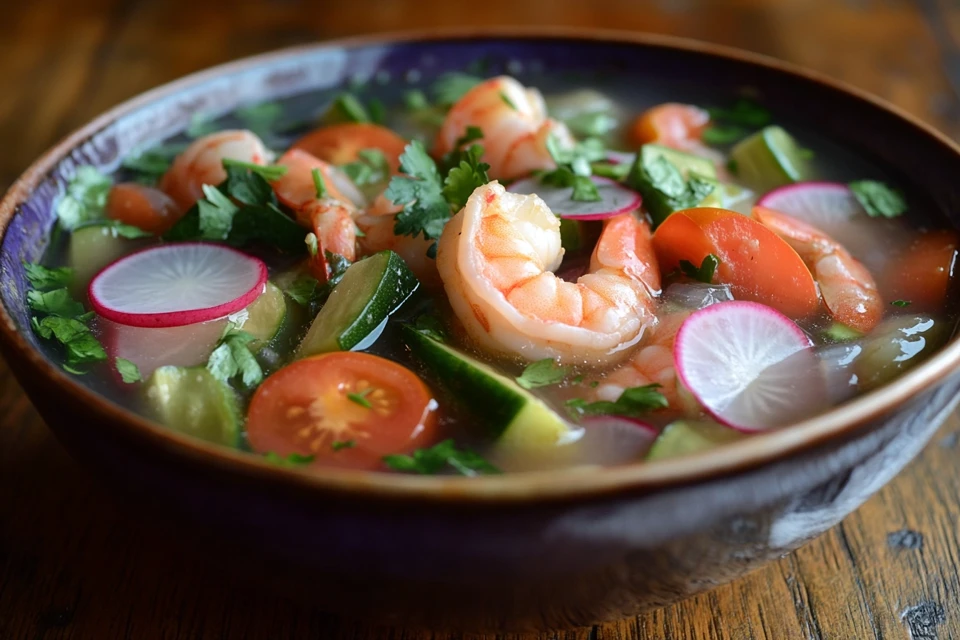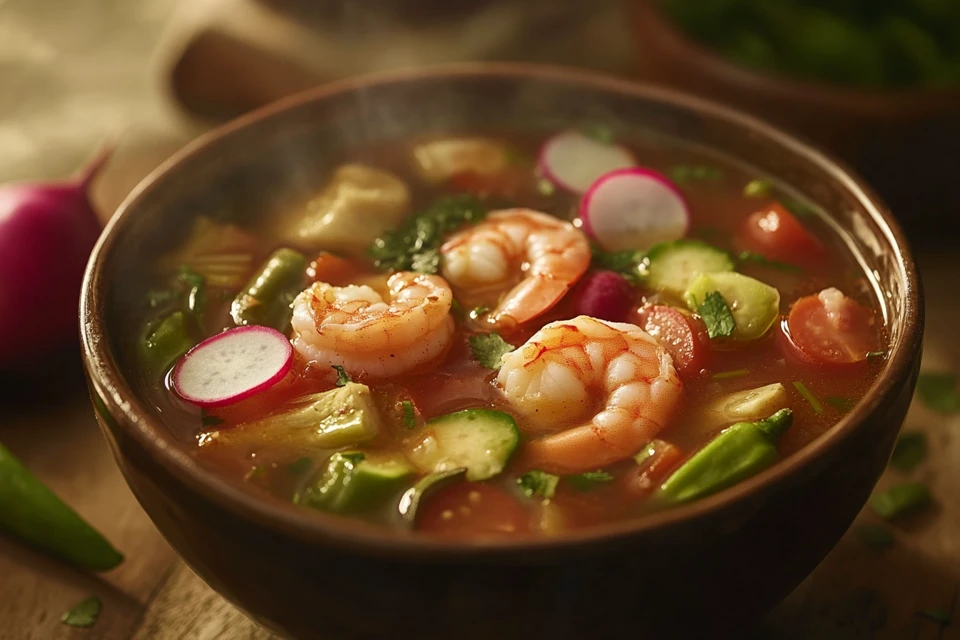The Ultimate Shrimp Sinigang Recipe: A Filipino Classic
Sinigang is a beloved Filipino dish that has become a staple in many households. With its tangy and savory broth, it’s a comfort food that many people look forward to on rainy days or when they crave something flavorful and satisfying. In this article, we will explore everything you need to know about making the perfect Sinigang Recipe Shrimp, from its origins to the essential ingredients and a step-by-step recipe.
What is Sinigang? A Filipino Culinary Tradition
Sinigang is a sour soup or stew that features various proteins, from pork to beef, and even seafood. The signature element of Sinigang is its sour broth, typically made with tamarind. This dish is versatile, as it adapts to the available ingredients and regional preferences across the Philippines. Whether enjoyed with rice or as a standalone dish, Sinigang is a culinary treasure in Filipino cuisine.
Why Shrimp Makes the Perfect Protein for Sinigang Recipe Shrimp
Shrimp is one of the most popular proteins for Sinigang Recipe Shrimp, particularly for seafood lovers. Its natural sweetness complements the sourness of the broth, creating a harmonious balance of flavors. Not only does shrimp absorb the broth’s flavors well, but its tender texture also adds a satisfying bite to each spoonful.
Health Benefits of Adding Shrimp to Sinigang
In addition to its delicious flavor, shrimp offers numerous health benefits. Rich in protein, omega-3 fatty acids, and essential minerals like iodine and selenium, shrimp makes Sinigang a nutritious and filling meal. It’s low in calories but high in vitamins and nutrients, which makes it a healthy option for anyone looking to boost their diet with wholesome ingredients.
Key Ingredients for the Perfect Shrimp Sinigang
Now that we understand why shrimp is such an excellent choice for this dish, let’s go over the key ingredients that will make your Sinigang Recipe Shrimp stand out.
Fresh Shrimp: Choosing the Right Type
The type of shrimp you choose is crucial for the flavor and texture of your Sinigang. It’s best to use fresh, large shrimp with the shells on. Not only do the shells contribute extra flavor to the broth, but they also help to keep the shrimp moist and tender. Always look for shrimp that are firm to the touch and have a mild, sweet scent – never fishy!
Vegetables: Essential Additions for Flavor and Texture
Vegetables play an important role in Sinigang, adding flavor, texture, and nutritional value to the dish. Some key vegetables typically included are:
- Kangkong (Water Spinach): This leafy green adds a fresh, earthy flavor.
- Radish (Labanos): With its mild, slightly peppery taste, radish balances out the sourness of the broth.
- Eggplant (Talong): Adds a creamy texture and a slight bitterness that complements the other flavors.
- Okra: Not only does it bring a unique texture to the dish, but it also helps thicken the broth.
You can also add tomatoes, string beans, and other vegetables to suit your preferences.
How to Make the Best Shrimp Sinigang: A Step-by-Step Guide
Ready to cook? Here’s a simple and delicious recipe for making Sinigang Recipe Shrimp that will surely become a household favorite.
Step 1: Prepare the Shrimp and Vegetables
Before cooking, peel and devein the shrimp (leave the tails on for presentation). Then, slice the radish into thin rounds, cut the eggplant into strips, and prepare the okra by slicing it in half. Wash the water spinach and set it aside for later.
Step 2: Create the Sour Broth
- Boil the Water: In a large pot, bring water to a boil over medium heat.
- Add the Tamarind or Sinigang Mix: If you’re using fresh tamarind, add it to the pot and let it boil. You can also use a Sinigang mix for a quicker version.
- Add the Tomatoes and Onion: Once the tamarind has dissolved, add the onions and tomatoes. Let them cook for about 10 minutes to release their flavors.
- Adjust the Sourness: Taste the broth and adjust the sourness according to your liking. Add more tamarind or Sinigang mix if needed.
Step 3: Add the Shrimp and Vegetables
- Add the Shrimp: Once the broth has reached your desired flavor, add the shrimp and let them cook for about 3-5 minutes until they turn pink.
- Add the Vegetables: Add the prepared vegetables, starting with the ones that take the longest to cook, such as radish and eggplant. Follow up with okra and water spinach, cooking everything for an additional 5-10 minutes.
Step 4: Taste and Adjust
After everything is cooked, taste the broth one last time. If it’s too sour, you can add a little sugar or a splash of fish sauce for balance. If it’s not sour enough, simply add more tamarind or Sinigang mix.
Common Problems and Solutions in Making Shrimp Sinigang
Sinigang is relatively easy to make, but there are some common problems that might arise. Here’s how to troubleshoot them:
Problem 1: Broth Too Sour?
If your broth turns out too sour, there are a couple of ways to fix it. First, you can add a small amount of sugar to balance out the sourness. Another option is to dilute the broth with more water and season it again with fish sauce or salt.
Problem 2: Shrimp Overcooked?
Shrimp cooks very quickly, so it’s essential not to overcook them. If the shrimp are rubbery or tough, this might be the case. To avoid this, always add the shrimp last, after the broth has been simmering for a while. Keep an eye on them and remove them from the heat as soon as they’re pink and opaque.
Problem 3: Broth Lacks Depth of Flavor?
If your broth seems flat or lacks complexity, you can deepen the flavor by adding more seasonings. A dash of fish sauce or a bit of salt will help bring out the umami notes. Additionally, roasting the vegetables like tomatoes and onions before adding them to the pot can enhance their flavor.
Tips for the Perfect Shrimp Sinigang Every Time
- Use fresh, quality shrimp: Fresh shrimp makes a huge difference in flavor and texture.
- Taste as you go: Don’t be afraid to adjust the sourness and seasoning to suit your taste.
- Add variety with vegetables: Feel free to experiment with different veggies like string beans or baby corn to make the dish your own.
More Tips, Variations, and FAQs About Shrimp Sinigang
Welcome back to the second part of our Shrimp Sinigang journey! If you’ve followed the first part, you now have a solid understanding of the basics of making this delicious Filipino dish. But there’s more to explore! Let’s dive deeper into some expert tips, variations you can try, and answer some frequently asked questions (FAQs) to help you elevate your Sinigang game to the next level.
Enhancing the Flavor: Expert Tips for the Best Shrimp Sinigang
No two batches of Sinigang are the same, and there are countless ways to tweak the recipe to suit your personal taste. Here are some expert tips to ensure your Shrimp Sinigang is always perfectly flavorful.
1. Use Different Types of Tamarind for Depth
While fresh tamarind is the most traditional ingredient to give your Sinigang that signature sourness, you can also try tamarind paste or concentrate. Tamarind paste has a richer, deeper flavor that’s more concentrated, which can add an extra layer of depth to your broth. You can even use sinigang mix (commercially available) for a faster option.
Some people enjoy mixing tamarind with other souring agents like green mango or calamansi (Filipino lime) to vary the sour profile. Experiment with these to find your perfect balance!
2. Infuse Umami with Fish Sauce or Shrimp Paste
While tamarind provides the tang, fish sauce or shrimp paste (bagoong) brings out that signature umami flavor, making your broth even more savory. You only need a little bit — too much, and it can overpower the dish. Start with a tablespoon, then taste and adjust.
3. Don’t Forget the Garnishes
A good garnish can elevate any dish, and Sinigang is no exception. Consider garnishing your shrimp Sinigang with freshly chopped spring onions or a sprinkle of crispy fried garlic. These additions will provide an aromatic finish to the dish and enhance its flavor profile.
Popular Variations of Shrimp Sinigang
While the classic Shrimp Sinigang is a hit for many, there are several delicious variations you can try depending on your taste preferences or dietary needs.
1. Sinigang na Hipon sa Miso (Shrimp Sinigang with Miso)
Adding miso to your Sinigang broth introduces a deep, savory flavor that pairs wonderfully with shrimp. This variation, called Sinigang na Hipon sa Miso, features a miso-based broth that’s slightly thicker and more earthy. The salty notes from the miso complement the shrimp’s sweetness and the sourness of the tamarind.
2. Sinigang na Hipon with Coconut Milk (Sinigang na Hipon sa Gata)
For a rich, creamy twist, try Sinigang na Hipon sa Gata. This version of Shrimp Sinigang incorporates coconut milk, which adds a silky texture and a sweet, nutty flavor that balances out the acidity of the tamarind. It’s perfect for those who want to enjoy the traditional sourness with a creamy twist!
3. Spicy Shrimp Sinigang (Sinigang na Hipon na Maanghang)
If you love a little heat in your meals, adding chili peppers to your Sinigang can take the dish to the next level. You can either add fresh green chilies or use siling labuyo (Filipino bird’s eye chili) to infuse your soup with spiciness. The warmth from the chili creates a lovely contrast with the tangy and savory broth.
4. Sinigang na Hipon with Buko (Coconut)
If you’re feeling adventurous, you can also try adding fresh buko (young coconut) to your Sinigang. The natural sweetness and refreshing quality of the coconut lend a lovely contrast to the sharpness of the tamarind, creating a unique and balanced flavor profile that’s perfect for summer.
Frequently Asked Questions (FAQs) About Shrimp Sinigang
Let’s answer some common questions that people often have when making Shrimp Sinigang.
1. Can I Use Frozen Shrimp for Sinigang?
Absolutely! While fresh shrimp is always the best option for the most tender and flavorful result, frozen shrimp can be a convenient alternative. Just make sure to thaw the shrimp completely before adding them to the broth. Frozen shrimp often have more moisture, so be careful not to overcook them.

2. Can I Make Shrimp Sinigang Ahead of Time?
Yes, you can make Shrimp Sinigang in advance! In fact, many people say that Sinigang tastes even better the next day once the flavors have had time to meld together. To store it, let the dish cool completely before transferring it to an airtight container. Reheat it on the stovetop, adding extra water if necessary, and adjust the seasoning to your taste.
3. Can I Use Other Seafood Instead of Shrimp?
Definitely! Shrimp is the most common seafood used in Sinigang, but you can substitute it with other types of seafood like fish, squid, or crab. Just make sure to adjust the cooking time, as different seafood types cook at varying rates.
For example, fish fillets might cook quicker than shrimp, while crab might take longer.
4. How Do I Make Sinigang Recipe Shrimp Less Sour?
If you find your Sinigang to be too sour, you can dilute the broth with some additional water or add sugar to balance the acidity. Alternatively, you can add a bit of fish sauce or soy sauce to mellow out the tanginess. Just remember to taste as you go to avoid overcorrecting.
5. What Do I Serve with Sinigang Recipe Shrimp?
Sinigang is typically served with a side of steamed rice, which soaks up the flavorful broth. Some people also enjoy it with fried fish or a side of bagoong (fermented shrimp paste) for extra flavor.
Final Thoughts: Making Shrimp Sinigang Your Own
Sinigang na Hipon is more than just a dish; it’s a celebration of Filipino culture, flavors, and family traditions. Whether you’re cooking it for a cozy dinner or sharing it with friends at a gathering, it’s a dish that brings people together and creates lasting memories.
With the tips, variations, and FAQs in this article, you have all the knowledge to make the best Shrimp Sinigang every time. Don’t be afraid to experiment with flavors, try different ingredients, and make the dish your own. After all, the beauty of Sinigang lies in its versatility!
Thank you for following along with this guide! If you’re ready to take your Sinigang skills to the next level, dive into the recipe and share the love with your friends and family. 🍤🍲 Happy cooking!
Sinigang Recipe with Shrimp: A Flavorful Filipino Delight
Sinigang is a beloved Filipino dish known for its tangy and savory flavor, traditionally made with tamarind broth. In this article, we’ll walk you through how to make Sinigang with Shrimp, a dish that is both comforting and packed with flavor.
Ingredients for Sinigang with Shrimp
To make the perfect Sinigang with Shrimp, you’ll need fresh shrimp, various vegetables, and the all-important souring agent. The list includes:
- Fresh shrimp (peeled and deveined)
- Tomatoes, onions, and radishes
- Tamarind paste (for the signature sour taste)
- Water spinach or kangkong
Step-by-Step Instructions
- Preparing the Broth
Start by bringing water to a boil. Add the tamarind paste and let it dissolve to infuse the broth with a tangy flavor. You can adjust the sourness by adding more tamarind paste or other souring agents like sinigang mix. - Cooking the Shrimp and Vegetables
Once the broth has reached the desired sourness, add the shrimp and cook for about 5-7 minutes until tender. You can also include water spinach and radishes for added texture.
The Best Side Dishes to Pair with Sinigang
To complement the bold flavors of Sinigang, consider pairing it with other Filipino dishes. A great choice could be a Chicken and Shrimp Recipe for a protein-packed meal or a simple Pastina Soup for a lighter side.
Conclusion: Why You’ll Love Sinigang with Shrimp
This dish is not only delicious but also a healthy choice with its fresh vegetables and lean shrimp. If you’re looking for more seafood-inspired dishes, explore our collection of shrimp and seafood recipes.
Internal Link Suggestions:
- Tamarind Paste: Link to a post about tamarind, its uses, or perhaps a recipe related to tamarind.
- Sinigang Mix: If your audience prefers convenience, offer insights into ready-made mixes, or highlight other soup-based recipes from your site.
- Water Spinach (Kangkong): Link to a recipe using this ingredient or a post discussing Filipino vegetables.
- Shrimp and Seafood Recipes: If your audience enjoys shrimp dishes, direct them to more recipes on your site related to shrimp or seafood.
- Tamarind (Sour Agent for Sinigang):
- Link to an external page explaining the health benefits of tamarind or its cultural significance in Filipino cuisine. For example, you could link to a reputable site like WebMD or an article that dives into the health benefits of tamarind.
- Sinigang Ingredients and Varieties:
- Link to a trusted food science or cultural website such as Serious Eats to provide additional insights into different types of souring agents used in Sinigang, including tamarind, guava, or kamias.
- Shrimp and Seafood Health Benefits:
- Link to articles or scientific studies about the health benefits of shrimp or seafood. A great option would be an article on a health and nutrition-focused site like Healthline.
- Cultural Importance of Sinigang in Filipino Cuisine:
- Provide a link to a reputable article or blog that talks about Filipino food culture or Sinigang’s history. For example, you can link to cultural or culinary sites like The Kitchn or an educational site about Filipino history.
- More Filipino Recipes:
- You could link to a well-known culinary site like Bon Appetit that features Filipino recipes or international cuisine to offer additional context to your readers.
Tamarind Paste for Sinigang
Tamarind paste is the secret ingredient that gives Sinigang its signature tang. If you’re unfamiliar with tamarind, you can learn more about this incredible fruit and its health benefits.
The Variety of Sinigang Broths
Did you know that Sinigang can be made with a variety of souring agents like guava or kamias? Explore more about the different souring agents used in Sinigang across the Philippines and how they affect the flavor profile of this iconic dish.
Health Benefits of Shrimp
Not only is shrimp delicious, but it’s also packed with essential nutrients. Discover more about the health benefits of shrimp in this article.

